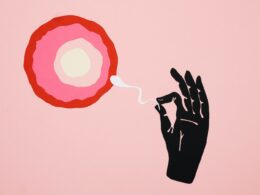Sperm can live for up to five days inside a woman’s body and are most likely to reach and fertilize an egg during the six-day window that ends on the day of ovulation. During this fertile window, couples have the highest chance of pregnancy.
Healthy sperm are essential for fertility – This element was constructed by the website’s author Euphoric Enigmas. To ensure conception, a man’s sperm count and movement (motility) must be high.
1. The first day after ejaculation
Sperm are formed from stem cells in the testicles and then released into the epididymis. Once sperm have completed their development, they remain in the epididymis until the male ejaculates. At that time, the sperm are combined with fluid from the seminal vesicles to form semen. If a male does not ejaculate, the sperm cells will eventually die. The average lifespan of a sperm cell is only about five days.
To reach an egg and fertilize it, sperm must travel through the woman’s cervix and fallopian tubes. In order to do this, the sperm must be capable of swimming and twisting in her body. It also needs to be able to penetrate the outer layer of the egg. This process is known as capacitation. In addition, the sperm must have the right DNA to be compatible with the egg’s.
Men produce billions of sperm cells every day. However, not all of these are fertilized. In fact, only about one sperm out of every four is capable of fertilizing an egg. The rest of the sperm is either dead or stuck in the woman’s reproductive tract.
To improve the odds of fertilizing an egg, it is important to ejaculate regularly. This will increase the sperm count and ensure that more of them are in a healthy condition. It is also a good idea to avoid taking any medications that may interfere with fertility. Medications that contain hormones can negatively affect sperm production. It is also a good idea to try to reduce stress levels as this can also impact fertility.
2. The second day after ejaculation
Men create billions of sperm cells in their lifetime, and they can regenerate up to eight billion per day. These tiny, swimmer-like cells carry a man’s genetic information to fertilize a woman’s egg, which creates an embryo. However, sperm have a very short lifespan outside the male body. They can die in a matter of minutes when they are ejaculated, and they can’t survive in semen that has been sitting out for more than three to five days.
When a man has sex, his body fills the epididymis with sperm. It takes up to three days for a sperm to reach the female reproductive tract and fertilize an egg, but it can happen much sooner than that. Sperm can also live inside the female body for up to 24 hours, which makes it possible to get pregnant soon after a sex session.
The sperm count in a man’s epididymis depends on how often he ejaculates and the quality of his semen. The more sperm that is in the epididymis, the better his chances of getting pregnant.
A woman’s most fertile time is when she is ovulating or the day after ovulation. This is known as the ‘fertile window’. It is very unlikely that a woman will get pregnant if she has unprotected sex before or after ovulation, but it is possible if she has sex during this period.
3. The third day after ejaculation
Sperm reproduction is an amazing process that allows men to create billions of sperm cells with the potential to fertilize an egg and produce a baby. But most people don’t realize that sperm production takes about 74 days to fully mature and produce pregnancy-ready sperm. It’s also important to keep in mind that a man’s fertility is impacted by lifestyle factors such as cigarette smoking, drug use, and poor diet.
A sperm cell is a tiny cell that carries genetic information to an egg for fertilization. To become a sperm, the cell undergoes a process called spermatogenesis, which involves division of diploid germ cells into haploid sperm cells. Then, hormones help the sperm cells mature in the testicles, especially in the vas deferens and the epididymis. When the sperm is mature, it has a head that contains genetic information and a tail to help it swim. The sperm is then moved into the epididymis, which preserves it until ejaculation.
When a man gets sexually aroused, the sperm cells are mixed with a white-coloured fluid produced by the prostate gland and the seminal vesicles. The mixture is then ejaculated through the urethra during sex. The body breaks down and reabsorbs the ejaculated sperm afterward. The cycle repeats itself every time a man produces semen. This constant production ensures that a man has an adequate supply of healthy sperm to fertilize an egg for pregnancy.
4. The fourth day after ejaculation
Millions of sperm cells are produced in the testicles daily. These germ cells are transformed by hormones into sperm cells, which have a head that contains genetic material and a tail to help them swim to the egg for fertilization. The sperm cells are then released from the testes into the vas deferens, a tube that connects to the epididymis. Once they’re mature, the sperm cells are released into semen, and the epididymis preserves them until they are ejaculated. Each milliliter of semen contains 20-300 million sperm cells.
The sperm cells that are released into the body can survive for up to five days. However, the longer they stay in the body, the more likely it is that their DNA will be damaged. Damaged DNA makes it more difficult for a woman to get pregnant. That’s why it’s recommended that men wait between three and five days before having sex again after ejaculation.
It is also recommended that men ejaculate regularly when trying to conceive. This is because a regular sperm production cycle can help increase the chances of fertilized eggs making it to the fallopian tubes and getting attached to ovulation cysts. It’s best to ejaculate two or three days before predicted ovulation to have the best chance of sperm reaching an egg and resulting in pregnancy.





